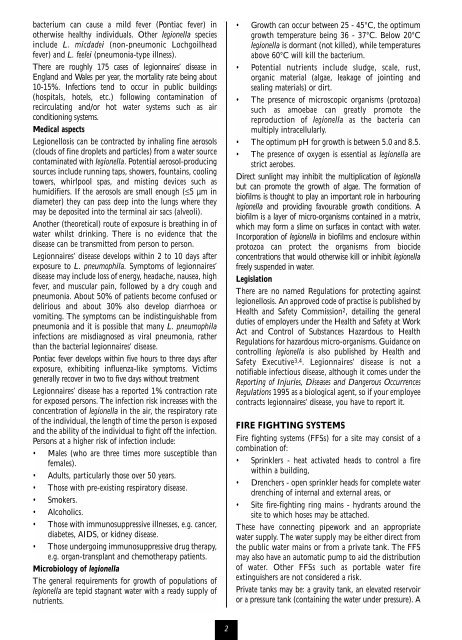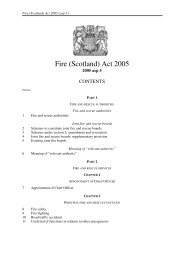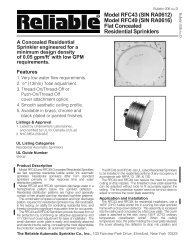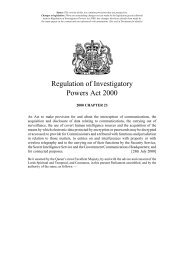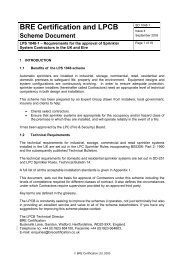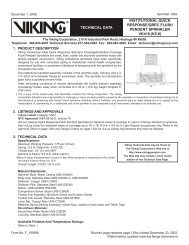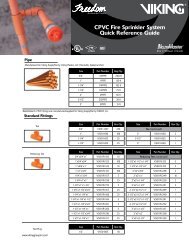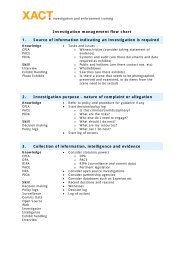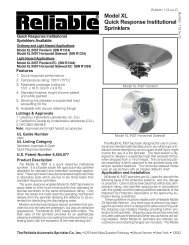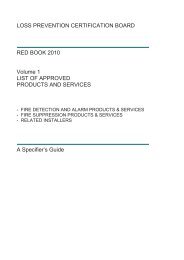Legionella and Fire Fighting Systems - Residential Sprinkler ...
Legionella and Fire Fighting Systems - Residential Sprinkler ...
Legionella and Fire Fighting Systems - Residential Sprinkler ...
You also want an ePaper? Increase the reach of your titles
YUMPU automatically turns print PDFs into web optimized ePapers that Google loves.
acterium can cause a mild fever (Pontiac fever) inotherwise healthy individuals. Other legionella speciesinclude L. micdadei (non-pneumonic Lochgoilheadfever) <strong>and</strong> L. feelei (pneumonia-type illness).There are roughly 175 cases of legionnaires’ disease inEngl<strong>and</strong> <strong>and</strong> Wales per year, the mortality rate being about10-15%. Infections tend to occur in public buildings(hospitals, hotels, etc.) following contamination ofrecirculating <strong>and</strong>/or hot water systems such as airconditioning systems.Medical aspectsLegionellosis can be contracted by inhaling fine aerosols(clouds of fine droplets <strong>and</strong> particles) from a water sourcecontaminated with legionella. Potential aerosol-producingsources include running taps, showers, fountains, coolingtowers, whirlpool spas, <strong>and</strong> misting devices such ashumidifiers. If the aerosols are small enough (≤5 µm indiameter) they can pass deep into the lungs where theymay be deposited into the terminal air sacs (alveoli).Another (theoretical) route of exposure is breathing in ofwater whilst drinking. There is no evidence that thedisease can be transmitted from person to person.Legionnaires’ disease develops within 2 to 10 days afterexposure to L. pneumophila. Symptoms of legionnaires’disease may include loss of energy, headache, nausea, highfever, <strong>and</strong> muscular pain, followed by a dry cough <strong>and</strong>pneumonia. About 50% of patients become confused ordelirious <strong>and</strong> about 30% also develop diarrhoea orvomiting. The symptoms can be indistinguishable frompneumonia <strong>and</strong> it is possible that many L. pneumophilainfections are misdiagnosed as viral pneumonia, ratherthan the bacterial legionnaires’ disease.Pontiac fever develops within five hours to three days afterexposure, exhibiting influenza-like symptoms. Victimsgenerally recover in two to five days without treatmentLegionnaires’ disease has a reported 1% contraction ratefor exposed persons. The infection risk increases with theconcentration of legionella in the air, the respiratory rateof the individual, the length of time the person is exposed<strong>and</strong> the ability of the individual to fight off the infection.Persons at a higher risk of infection include:• Males (who are three times more susceptible thanfemales).• Adults, particularly those over 50 years.• Those with pre-existing respiratory disease.• Smokers.• Alcoholics.• Those with immunosuppressive illnesses, e.g. cancer,diabetes, AIDS, or kidney disease.• Those undergoing immunosuppressive drug therapy,e.g. organ-transplant <strong>and</strong> chemotherapy patients.Microbiology of legionellaThe general requirements for growth of populations oflegionella are tepid stagnant water with a ready supply ofnutrients.• Growth can occur between 25 - 45°C, the optimumgrowth temperature being 36 - 37°C. Below 20°Clegionella is dormant (not killed), while temperaturesabove 60°C will kill the bacterium.• Potential nutrients include sludge, scale, rust,organic material (algae, leakage of jointing <strong>and</strong>sealing materials) or dirt.• The presence of microscopic organisms (protozoa)such as amoebae can greatly promote thereproduction of legionella as the bacteria canmultiply intracellularly.• The optimum pH for growth is between 5.0 <strong>and</strong> 8.5.• The presence of oxygen is essential as legionella arestrict aerobes.Direct sunlight may inhibit the multiplication of legionellabut can promote the growth of algae. The formation ofbiofilms is thought to play an important role in harbouringlegionella <strong>and</strong> providing favourable growth conditions. Abiofilm is a layer of micro-organisms contained in a matrix,which may form a slime on surfaces in contact with water.Incorporation of legionella in biofilms <strong>and</strong> enclosure withinprotozoa can protect the organisms from biocideconcentrations that would otherwise kill or inhibit legionellafreely suspended in water.LegislationThere are no named Regulations for protecting againstlegionellosis. An approved code of practise is published byHealth <strong>and</strong> Safety Commission 2 , detailing the generalduties of employers under the Health <strong>and</strong> Safety at WorkAct <strong>and</strong> Control of Substances Hazardous to HealthRegulations for hazardous micro-organisms. Guidance oncontrolling legionella is also published by Health <strong>and</strong>Safety Executive 3,4 . Legionnaires’ disease is not anotifiable infectious disease, although it comes under theReporting of Injuries, Diseases <strong>and</strong> Dangerous OccurrencesRegulations 1995 as a biological agent, so if your employeecontracts legionnaires’ disease, you have to report it.FIRE FIGHTING SYSTEMS<strong>Fire</strong> fighting systems (FFSs) for a site may consist of acombination of:• <strong>Sprinkler</strong>s - heat activated heads to control a firewithin a building,• Drenchers - open sprinkler heads for complete waterdrenching of internal <strong>and</strong> external areas, or• Site fire-fighting ring mains - hydrants around thesite to which hoses may be attached.These have connecting pipework <strong>and</strong> an appropriatewater supply. The water supply may be either direct fromthe public water mains or from a private tank. The FFSmay also have an automatic pump to aid the distributionof water. Other FFSs such as portable water fireextinguishers are not considered a risk.Private tanks may be: a gravity tank, an elevated reservoiror a pressure tank (containing the water under pressure). A2


